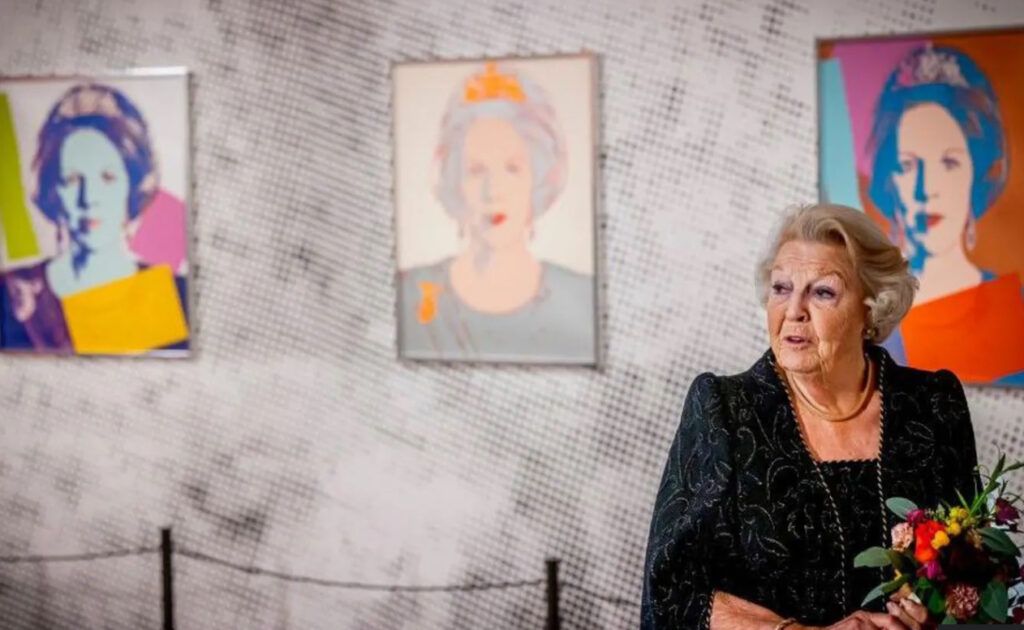The absurd has long been a companion to the art world. Yet rarely does it arrive as quietly, as bureaucratically, or as clumsily as it did in Maashorst, a modest Dutch municipality that recently—and by its own admission—“most likely” discarded 46 artworks, including a 1980s Andy Warhol silkscreen of Queen Beatrix. Not lost, not stolen. Thrown away.
The silkscreen, modest by Warhol standards with an estimated worth of €15,000, was among nearly four dozen works reportedly stored in a basement during town hall renovations. It is here, in this bleak, subterranean staging ground for supposed safekeeping, that the artworks were “mistakenly” removed—likely sent to landfill or incinerator alongside plaster debris and defunct wiring. No alarms were raised. No inventory was checked. Just a quiet disappearance, now acknowledged with a shrug and a statement: “We regret that.”
This is not merely the story of a local government’s clerical failure. It is an indictment of the widening chasm between civic bureaucracy and cultural responsibility. It speaks to the hollowness that can develop when institutional memory, public trust, and artistic value are reduced to footnotes in an operations manual. In Maashorst, art did not perish in scandal. It died in a trash compactor.
The Warhol Factor: Iconography in the Age of Indifference
Andy Warhol’s 1980s portrait of Queen Beatrix is not among his most famous works. It does not command the mythology of his Marilyns or the commercial fervor of the Campbell’s Soup Cans. Yet in its own right, it is a distinctly Warholian artifact: monarch reimagined as media, sovereign distilled into screenprint. For the Netherlands, it is both pop culture and national portraiture—a confluence of outsider art and insider legacy.
That it was held in the town hall’s public collection at all is a testament to the quiet, democratic ubiquity of art in Dutch civic life. This is a nation where municipal buildings frequently house works by significant artists, where cultural access is woven into the administrative fabric. Or at least, it was.
To lose a Warhol—any Warhol—through negligence rather than theft is not merely unfortunate. It’s unthinkable. In the global art world, Warhol’s name carries weight not just because of aesthetic value, but because of his role in reshaping the economics of celebrity, reproduction, and collectability. His works have been exhibited in major museums, fetched astronomical sums at auction, and inspired generations of contemporary artists. And yet here, a piece of that legacy was mistakenly treated as refuse. What does that say about the systems we trust to guard our shared heritage?
From Storage to Silence: The Bureaucratic Unraveling
According to the Maashorst municipality’s internal investigation, the works were placed in the basement during renovations—a temporary move made without a clear preservation protocol. No documented chain of custody. No security. No red tags reading “Do Not Remove.” A gap, it appears, was left where policy should have been.
This is how cultural memory is erased—not by fire, flood, or war, but by the absence of a spreadsheet.
What makes the situation galling is not just the accident itself, but the tenor of the response. Mayor Hans van der Pas admitted on public broadcaster Omroep Brabant: “That’s not how you treat valuables. But it happened. We regret that.” There is a chilling understatement in this phrasing, as if someone had misplaced a coffee machine, or a stack of bureaucratic memos. The passive voice—“it happened”—functions as a shield, turning administrative failure into inevitability.
And yet, at the heart of this incident is a deeply human oversight: someone, or several someones, made a decision based on expedience. Perhaps it was a worker clearing the space. Perhaps it was a foreman checking boxes. But the larger truth is structural. When there are no guidelines, no enforced custodianship, art ceases to be art. It becomes clutter.
Cultural Capital and Municipal Myopia
This incident lays bare a broader issue: how institutions, particularly smaller municipalities, undervalue the art they hold. Often, these works are seen not as cultural treasures, but as furnishings—items that decorate hallways, wait in archives, or hang behind podiums. When budgets tighten and renovations begin, they are the first things to be packed away, the last to be accounted for.
But this is not unique to Maashorst. Across Europe—and the world—public art collections suffer from under-inventory, underfunding, and underappreciation. Works are misplaced during government reshufflings, deaccessioned without transparency, or left to decay in storage. There are no viral moments for lost municipal art. No documentaries. No high-stakes heists. Just a slow leak.
The Maashorst case only made headlines because of the Warhol. Had the collection included only regional painters or lesser-known draftsmen, the error may never have surfaced. The loss would still be real. But the name “Warhol”—that strange, echoing icon—was enough to pierce the veil of procedural indifference.
Art in the Age of Disposable Everything
We are living in a time when even the most venerated cultural artifacts are at risk of becoming disposable. Not because they are unloved, but because they are misunderstood—reduced to line items, or worse, logistical liabilities.
Warhol’s art itself prophesied this moment. He transformed mass production into an aesthetic, screenprinting the same image in different hues, multiplying fame until it fractured. He once said: “I want to be a machine.” And in a dark irony, a literal machine—a trash compactor, a disposal truck—may have ultimately consumed his work.
The problem is not with the medium, but with the mindset. If art can be lost simply because it was in the way, then its value is contingent on context—not on meaning, not on legacy, not on beauty. This signals a dangerous precedent for public institutions. It says: if no one is watching, nothing is sacred.
The Ethics of Stewardship: A Call for Reform
Beyond outrage and resignation, the Maashorst debacle demands a deeper reckoning with how public art is cataloged, stored, and protected. The moral responsibility of cultural stewardship cannot be divorced from administrative protocol. If a municipality lacks the infrastructure to track its art, it must build it. If employees are unaware of their custodial duties, they must be educated. To do less is not just negligence—it is cultural vandalism.
What makes public art so vital is not just its existence, but its accessibility. These pieces do not dwell in ivory towers or behind velvet ropes. They are, by design, democratic. They are the faces of our collective identity, displayed in shared spaces, seen by schoolchildren, civil servants, and citizens alike. To lose them is to lose part of the narrative of who we are.
This is why record-keeping, digital inventories, and preservation protocols must no longer be considered optional. If we can track shipments of staplers and office chairs, we can—we must—track artworks.
What Was Lost Beyond the Frame
The loss of the Warhol print is tangible, but what was lost alongside it may be more difficult to restore: public trust, cultural continuity, and a sense of reverence for shared heritage.
Art does not just reflect society. It roots it. A portrait of Queen Beatrix by Warhol is more than a print—it is a historical conversation between pop culture and royalty, between artist and nation. Its disappearance cuts off that dialogue. The silence that follows is not neutral—it’s erasure.
This should be a national conversation, not a local one. Because the Maashorst case, in its quiet tragedy, poses urgent questions: How do we honor the art we inherit? What systems are in place to protect it? And how do we respond when those systems fail?
Impression
In 1942, amid the chaos of war, the Nazis raided Dutch museums and took masterpieces. Those losses were the result of ideological violence. In Maashorst, the destruction came from indifference.
There is no villain here—only a vacuum. A silence where accountability should be. A shrug where reverence once stood.
Art deserves more. It deserves memory, care, and a future. The Warhol of Queen Beatrix, if indeed lost forever, now serves as a symbol: a queen dethroned not by rebellion, but by neglect. A nation’s image discarded not out of malice, but out of mismanagement.
Let this not be forgotten. Let this not become just another anecdote of civic incompetence. Let it be a wake-up call—for municipalities, for custodians, for all of us—to treat art not as a burden, but as the burdened: heavy with memory, delicate in form, and worthy of being carried forward.
No comments yet.







